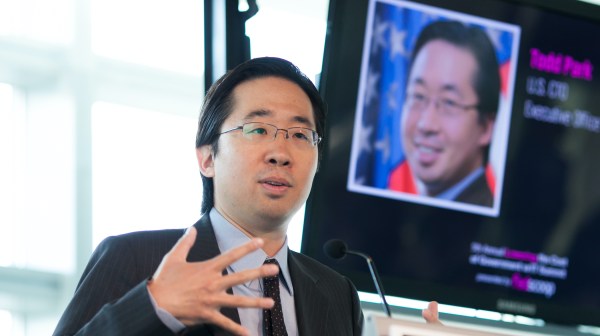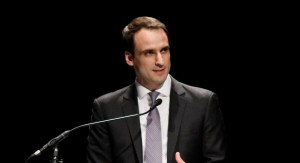
Last Tuesday, the day before announcing the Green Button initiative in California, Federal Chief Technology Officer Aneesh Chopra was at the offices of San Francisco-based start-up Twilio.
The mission of the talk was simple: How can the government harness innovative companies like Twilio without spending a penny to integrate them into the government systems?
Part of the talk moved to the Veterans Apps Showcase, when Chopra issued a challenge using MOS data (a military code used for different jobs descriptions) to the 200 or so in the room.
“Aneesh is on the stage doing Aneesh things. He is a life force if there ever was one. When he looks at the company CEO [Jeff Lawson] in the back of the room and says, ‘Hey! Why can’t we build a cloud communications tool that takes the MOS code and a phone number of a veteran and pushes them job opportunities,” said Department of Veterans Affairs Chief Technology Officer Peter Levin, who was with Chopra at the time and shared the anecdote in an interview with FedScoop.
Lawson says “sure,” and Aneesh asks another tough question: “By tomorrow?”
Knowing the government likely won’t pay for such a solution, Lawson asks what’s in it for him and his team, recounts Levin. Aneesh offers him a meet-and-greet with Second Lady Dr. Jill Biden at an “Apps for Heroes” event the next day in San Francisco.
Lawson took the challenge, sending it to the network of 75,000 developers that use Twilio’s platform.
Within 30 minutes, there was a solution.
“We test it the next morning and it works like a dream. So, here the CEO gets to meet Dr. Biden and the government gets a quick solution to helping vets find more jobs,” Levin said.
That story, in many ways, encapsulates the spirit of innovation Chopra brought to government in his nearly three years as the nation’s first Federal CTO: A mix of enthusiasm, energy, passion, ingenuity and a get-it-done spirit that brought a certain coolness to government technology.
It also showed how Chopra, and federal government technology innovators like Levin and Department of Health and Human Services Todd Park, are working to bring the latest innovations from the private sector to the government that can be widely harnessed for the public good.
Imagine the above story just a few years ago. If a government official wanted to create the above solutions, it would take months or years of approvals, regulations, standardization followed by a lengthy procurement process.
“We’re launching a new model of government, and that’s best described as a government that is playing the role of impatient convener,” Chopra told attendees at last week’s “Apps for Heroes” event. “We have resources, information as a resource to this technology-driven economy, and it is our responsibility to make it accessible so that all of you can do your thing.”
President Obama nominated Chopra as the nation’s first CTO in 2009 after he spent the previous three years as the CTO for the State of Virginia, where he worked closely with future Federal Chief Information Officer Vivek Kundra, who was the state’s Assistant Secretary of Commerce and Technology.
Chopra’s areas of focus were wide. He was a pioneer in trying to find ways to use information technology in the government to make the healthcare process more efficient. He was a proponent of open source and open government, taking to the discussion site Quora to ask citizens for solutions on healthcare, clean energy and education, along with continually looking for ways that technology can help create jobs throughout the country, everywhere from inner cities to rural America.
“Our mission is to assist the President in harnessing the power and potential of technology, data and innovation to transform the Nation’s economy and improve the lives of everyday Americans,” Chopra said.
And he did.





